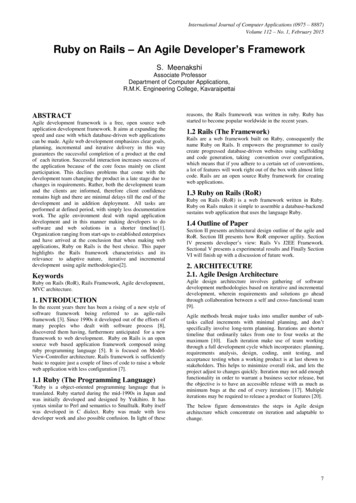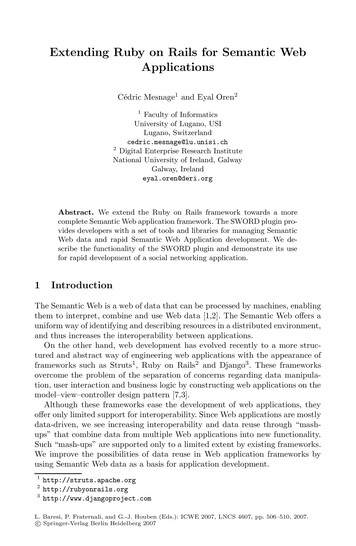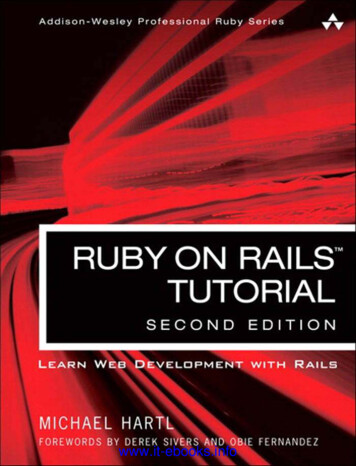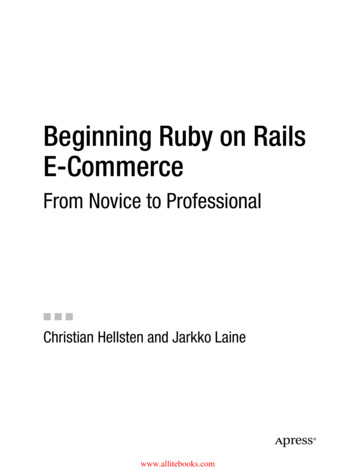
Transcription
Extracted from:Agile Web Development with Rails 6This PDF file contains pages extracted from Agile Web Development with Rails 6,published by the Pragmatic Bookshelf. For more information or to purchase apaperback or PDF copy, please visit http://www.pragprog.com.Note: This extract contains some colored text (particularly in code listing). Thisis available only in online versions of the books. The printed versions are blackand white. Pagination might vary between the online and printed versions; thecontent is otherwise identical.Copyright 2020 The Pragmatic Programmers, LLC.All rights reserved.No part of this publication may be reproduced, stored in a retrieval system, or transmitted,in any form, or by any means, electronic, mechanical, photocopying, recording, or otherwise,without the prior consent of the publisher.The Pragmatic BookshelfRaleigh, North Carolina
Agile Web Development with Rails 6Sam RubyDavid Bryant Copelandwith Dave ThomasThe Pragmatic BookshelfRaleigh, North Carolina
Many of the designations used by manufacturers and sellers to distinguish their productsare claimed as trademarks. Where those designations appear in this book, and The PragmaticProgrammers, LLC was aware of a trademark claim, the designations have been printed ininitial capital letters or in all capitals. The Pragmatic Starter Kit, The Pragmatic Programmer,Pragmatic Programming, Pragmatic Bookshelf, PragProg and the linking g device are trademarks of The Pragmatic Programmers, LLC.Every precaution was taken in the preparation of this book. However, the publisher assumesno responsibility for errors or omissions, or for damages that may result from the use ofinformation (including program listings) contained herein.Our Pragmatic books, screencasts, and audio books can help you and your team createbetter software and have more fun. Visit us at https://pragprog.com.The team that produced this book includes:Publisher: Andy HuntVP of Operations: Janet FurlowExecutive Editor: Dave RankinDevelopment Editor: Adaobi Obi TultonCopy Editor: Sakhi MacMillanIndexing: Potomac Indexing, LLCLayout: Gilson GraphicsFor sales, volume licensing, and support, please contact support@pragprog.com.For international rights, please contact rights@pragprog.com.Copyright 2020 The Pragmatic Programmers, LLC.All rights reserved. No part of this publication may be reproduced, stored in a retrieval system,or transmitted, in any form, or by any means, electronic, mechanical, photocopying, recording,or otherwise, without the prior consent of the publisher.ISBN-13: 978-1-68050-670-9Encoded using the finest acid-free high-entropy binary digits.Book version: P1.0—February 2020
In this chapter, you'll see: Using Webpacker to manage app-like Javascript Setting up a development environment thatincludes Webpack Using React to build a dynamic web form Using Capybara and ChromeDriver to test JavaScriptpowered featuresCHAPTER 13Task H: Entering AdditionalPayment DetailsOur customer is enthusiastic about our progress, but after playing with thenew checkout feature for a few minutes, she has a question: how does a userenter payment details? It’s a great question, since there isn’t a way to do that.Making that possible is somewhat tricky, because each payment methodrequires different details. If users want to pay with a credit card, they needto enter a card number and expiration date. If they want to pay with a check,we’ll need a routing number and an account number. And for purchase orders,we need the purchase order number.Although we could put all five fields on the screen at once, the customerimmediately balks at the poor user experience that would result. Can we showthe appropriate fields, depending on what payment type is chosen? Changingelements of a user interface dynamically is certainly possible with someJavaScript, but it’s quite a bit more complex than the JavaScript we’ve usedthus far. Rails calls JavaScript like this app-like JavaScript, and it includesa tool named Webpacker that will help us manage it. Webpacker will handlea lot of complex setup for us so that we can focus most of our efforts on givingour customer—and our users—a great experience checking out. (Refer backto Chapter 1, Installing Rails, on page ?, for installation instructions for thetools used in this chapter.)Iteration H1: Adding Fields Dynamically to a FormWe need a dynamic form that changes what fields are shown based on whatpay type the user has selected. While we could cobble something togetherwith jQuery, it would be a bit cleaner if we could use a more modern Click HERE to purchase this book now. discuss
6JavaScript library like React.1 This will also form a solid base from whichwe can easily add additional features later.Using JavaScript libraries or frameworks can often be difficult, as the configuration burden they bear is far greater than what we’ve seen with Rails. Tohelp us manage this complexity, Rails includes Webpacker, which providesconfiguration for Webpack.2 Webpack is a tool to manage the JavaScript filesthat we write. Note the similar names. Webpacker is a gem that’s part of Railsand sets up Webpack inside our Rails app.Managing JavaScript is surprisingly complex. By using Webpack we caneasily put our JavaScript into several different files, bring in third-partylibraries (like React), and use more advanced features of JavaScript not supported by a browser (such as the ability to define classes). Webpack thencompiles all of our JavaScript, along with the third-party libraries we areusing, into a pack. Because this isn’t merely sprinkling small bits of JavaScriptin our view, Rails refers to this as app-like JavaScript.While we could use Webpack directly with Rails, configuring Webpack isextremely difficult. It’s highly customizable and not very opinionated, meaningdevelopers must make many decisions just to get something working. Webpacker essentially is the decisions made by the Rails team and bundled upinto a gem. Almost everything Webpacker does is to provide a working configuration for Webpack and React so that we can focus on writing JavaScriptinstead of configuring tools. But Webpack is the tool that manages ourJavaScript day-to-day.React is a JavaScript view library designed to quickly create dynamic userinterfaces. We’ll use it to create a dynamic payment method details form, andWebpacker will ensure that the configuration and setup for all this is assimple as possible. That said, there’s a bit of setup we need to do.First, we’ll use Webpacker to install React. After that, we’ll replace our existingpayment-type drop-down with a React-rendered version, which will demonstratehow all the moving parts fit together. With that in place, we’ll enhance our Reactpowered payment type selector to show the dynamic form elements we want.Installing ReactWebpacker can install and configure some common JavaScript frameworkssuch as Angular, Vue, or React. We chose React because it’s the ://webpack.js.org Click HERE to purchase this book now. discuss
Iteration H1: Adding Fields Dynamically to a Form 7overall and is the best fit for solving our problem. To have Webpacker set itall up for us, run the task webpacker:install:react: bin/rails webpacker:install:reactCopying react loader to config/webpack/loaderscreate config/webpack/loaders/react.jsCopying .babelrc to app root directorycreate .babelrcCopying react example entry file to app/javascript/packscreate app/javascript/packs/hello react.jsxInstalling all react dependenciesrun ./bin/yarn add react react-dom babel-preset-react from "."yarn add v0.20.3[1/4] Resolving packages.[2/4] Fetching packages.[3/4] Linking dependencies.warning "react-dom@15.4.2" has unmet peer dependency "react@ 15.4.2".[4/4] Building fresh packages.success Saved lockfile.success Saved 26 new dependencies.«lotsof output»Done in 7.17s.Webpacker now supports react.jsIf you’ve ever tried to set up Webpack and a JavaScript framework like Reactbefore, you’ll appreciate how much work Webpacker has just done for us. Ifyou’ve never had the privilege, trust me, this saves a ton of time and aggravation.Webpacker also created a rudimentary React component in app/javascript/packs/hello react.jsx. Don’t worry about what that means for now. We’re going to use thisgenerated code to validate the installation and set up our development environment. This generated code will append the string “Hello React!” to the endof our page, but it’s not activated by default. Let’s find out why, configure itto be included in our views, and set up our development environment to worksmoothly with Webpacker.Updating Our Development Environment for WebpackWebpacker includes a helper method called javascript pack tag() that takes asan argument the name of the file in app/javascript/packs whose JavaScript shouldbe included on the page.The reason Rails doesn’t simply include all JavaScript all the time is that youmight not want that to happen for performance reasons. Although our paymentdetails code won’t be terribly complex, it’ll still be a chunk of code our userswill have to download. Since it won’t be needed anywhere else in our app, we Click HERE to purchase this book now. discuss
8can make the user experience faster and better by only downloading the codewhen it’s needed.Webpacker allows us to have any number of these separately managed packs.We can include any that we like, wherever we like. To see how this works,let’s add a call to javascript pack tag() to our app/views/orders/new.html.erb page tobring in the sample React component that Webpacker created for us.rails6/depot pa/app/views/orders/new.html.erb section class "depot form" h1 Please Enter Your Details /h1 % render 'form', order: @order % /section % javascript pack tag("hello react") % If you add some items to your cart and navigate to the checkout page, youshould see the string “Hello React!” at the bottom of the page, as shown inthe following screenshot.This validates that all the internals of Webpack are working with the app(which is always a good practice before writing code so we can be sure whatmight be the cause if something’s wrong). Now we can start building ourfeature. We need to replace the existing drop-down with one powered by Reactand our Webpacker-managed JavaScript. Doing that requires a slight diversionto learn about React. Click HERE to purchase this book now. discuss
in our view, Rails refers to this as app-like JavaScript. While we could use Webpack directly with Rails, configuring Webpack is extremely difficult. It's highly customizable and not very opinionated, meaning developers must make many decisions just to get something working. Web-packer essentially is the decisions made by the Rails team and .









